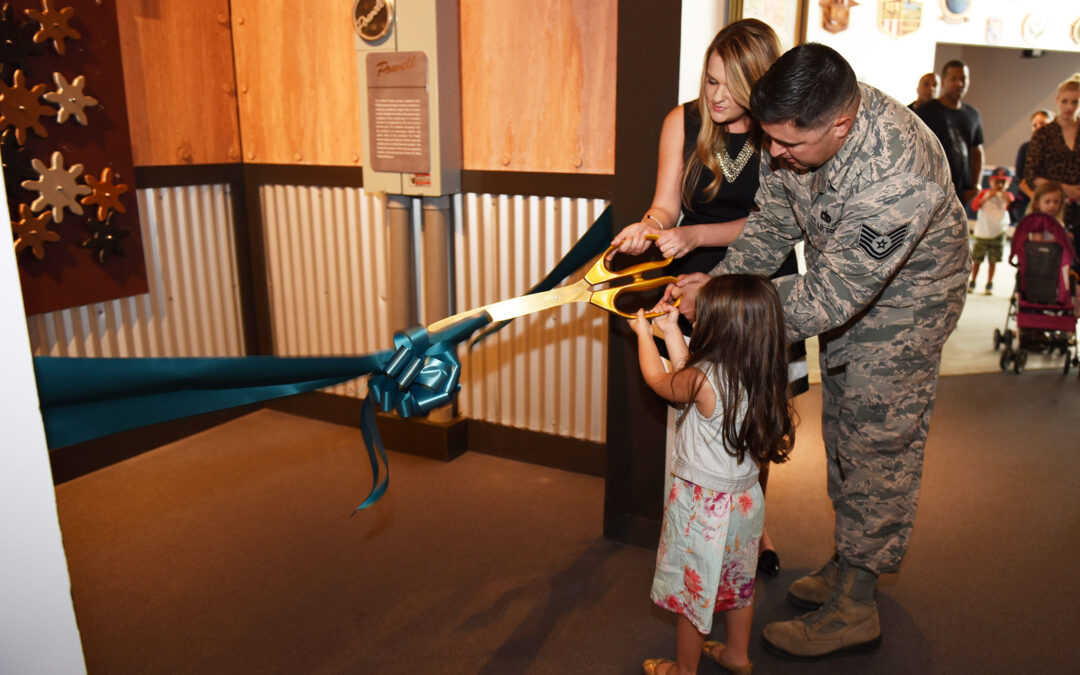PHOTO CAPTION: PORT HUENEME, Calif. (June 6, 2015) U.S. Air Force Tech Sgt. William Powell and his family cut the ribbon celebrating the opening of the Science, Technology, Engineering and Math (STEM) Center at the U.S. Navy Seabee Museum. The Powell Family raised the funds to build the center in memory of their daughter, Kennedy, who died in January 2014 from a rare illness when she was 15 months old. The exhibit will be the center of youth educational programming for the museum by tying in the educational tenets of STEM with the history and fundamentals of the Seabee job ratings. (Photo by Aramis X. Ramirez, Public Affairs Officer, U.S. Navy Seabee Museum/RELEASED)
During World War II many Seabees departing to and from the Pacific Theater left vast quantities of war memorabilia in Port Hueneme. By 1946, the building known as Theater C was overflowing with abandoned war souvenirs.
Commander Neil Kingsley, the Officer in Charge of the Training and Distribution Center, considered establishing a museum to stimulate interest in and preserve the history of the Seabees. Commodore Beauford W. Fink, the senior officer at Naval Construction Battalion Center, Port Hueneme, strongly supported the idea. After sifting through the collection of war artifacts, Kingsley initiated a campaign to obtain more Seabee-related memorabilia to balance the collections.
In October 1946, Theater C became the first official Seabee museum, and photographs, cruise books, uniforms, unit flags, newspapers, and other items were added to the museum’s collection; telling a more complete story of Seabee accomplishments during the war. A feat made possible only through the spirit of Seabee veterans and countless volunteers.
Over the next five decades, the museum was moved, rebuilt, and expanded repeatedly to keep up with the growing collection. In 1967 the Morrell Wing extension was opened to the public after Admiral Ben Moreell, the “Father of the Seabees,” donated his collection to the museum; most of his collection was displayed in that wing.
Moving into a new state-of-the-art building that was constructed to better preserve the Seabee legacy and to improve the visitor experience in 2011. This $12 million building was funded by the CEC/Seabee Historical Foundation through generous gifts and donations from Seabee veterans and other benefactors.
The Museum’s new building, along with its contemporary, interactive exhibits, Science, Technology, Engineering, and Math (STEM) Center, and the professional museum staff, has propelled its mission forward. Open to the public, it is now a destination for tourists eager to better understand the Seabees’ role in U.S. history and for veterans to be proud of their contribution to naval history.
The U.S. Navy Seabee Museum is one of ten official Department of the Navy museums and is operated by the Naval History and Heritage Command. As the U.S. Navy Seabee Museum has evolved, the Seabee community has never stopped supporting the museum and its mission to immortalize and share Seabee history. To learn more about the U.S Navy Seabee Museum visit http://www.seabeehistory.com/.

